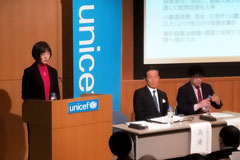‘Japan’s Human Security’ Indicator 2018 Symposium — Visiting Fellow Mine and Senior Research Fellow Muto Report Findings
2019.02.26
The United Nations declares “leaving no one behind” to be a principle of the Sustainable Development Goals (SDGs), but there is a growing recognition that it is inadequate to merely try to meet each target of the SDGs in order to accomplish this.
In this context, the Japan Human Security Indicator 2018 was developed to shed light on the realities of poverty, inequality, discrimination and exclusion in Japanese society. The Indicator was designed by a project team led by Yukio Takasu, Special Adviser on Human Security to the United Nations, and supported by volunteers from the NPO Human Security Forum, as well as experts and researchers in multiple fields. Several members from JICA Research Institute (JICA-RI) also joined the team: Yoichi Mine, a visiting fellow and a professor at Doshisha University, Ako Muto, a senior research fellow, and Oscar Gómez, a former JICA-RI research fellow who is now an assistant professor at Ritsumeikan Asia Pacific University.
To present the outcomes of the Indicator, the symposium took place on Dec. 15, 2018, at the UNICEF House in Tokyo, Japan, and was attended by more than 100 participants. After the official release of the Indicator, the experts made presentations about people who were left behind or tended to be marginalized, and proposed assistance measures that would focus on the conditions of those people.
The Indicator is composed of three indices, which are the core themes of human security: “life,” “livelihood” and “dignity.” In order to understand the geography of marginalization, these three indices are calculated from 92 variables based on prefecture-level statistics issued mainly by public agencies. The rankings of all prefectures were distributed in a handout.
In an attempt to gain the subjective perceptions of residents, the project team also conducted an online survey, asking participants questions on factors such as their anxiety, self-fulfillment and isolation. 5,450 people responded and the data was used to form the prefectural ranking. It was also listed in the handout.
Muto, who was responsible for the online survey, explained that the team tried to take into consideration differences such as gender, generation, region and prefecture as much as possible. Despite policies and institutions put in place by the central and the local governments, the team found that many people were still anxious about their old age, health, work, and lifestyle. She also reported that nearly a half of the respondents had no one who they could confide in about serious factors of distress, and a quarter answered that they could not find something worth living for.

JICA-RI Senior Research Fellow Ako Muto presented survey results
Mine, as a commentator at the symposium, introduced cases of famines analyzed by the Nobel Prize economist Amartya Sen. He pointed out that aggregate data about a single country is inadequate to understand the true state of a catastrophic event. He explained that difficulty in living depended on diverse attributes of individuals such as region, generation, occupation, gender and disability. He highlighted that the originality of the indicator lay in the incorporation of subjective variables that explained specific human insecurities people experience in everyday life, and the examination of their anxieties and hopes. He concluded by stressing the importance of answering questions of who suffers, where they suffer, and what problems they face in order for no one to be left behind.
The project team plans to publish books in Japanese and English based on the outcomes, while contributing to the ongoing discussions in the United Nations arena. The data will be updated regularly while accepting feedback from all parties, leading to the development of a globally applicable model.

事業事前評価表(地球規模課題対応国際科学技術協力(SATREPS)).国際協力機構 地球環境部 . 防災第一チーム. 1.案件名.国 名: フィリピン共和国.

事業事前評価表(地球規模課題対応国際科学技術協力(SATREPS)).国際協力機構 地球環境部 . 防災第一チーム. 1.案件名.国 名: フィリピン共和国.

事業事前評価表(地球規模課題対応国際科学技術協力(SATREPS)).国際協力機構 地球環境部 . 防災第一チーム. 1.案件名.国 名: フィリピン共和国.

事業事前評価表(地球規模課題対応国際科学技術協力(SATREPS)).国際協力機構 地球環境部 . 防災第一チーム. 1.案件名.国 名: フィリピン共和国.

事業事前評価表(地球規模課題対応国際科学技術協力(SATREPS)).国際協力機構 地球環境部 . 防災第一チーム. 1.案件名.国 名: フィリピン共和国.
scroll